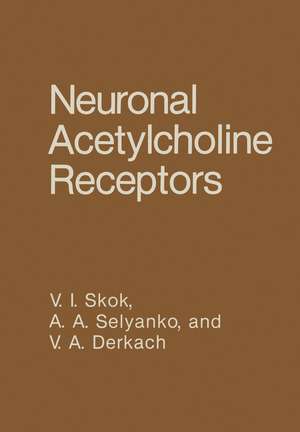Neuronal Acetylcholine Receptors
Autor V.I. Skok, A.A. Selyanko, V.A. Derkachen Limba Engleză Paperback – 21 mar 2012
Preț: 644.49 lei
Preț vechi: 758.23 lei
-15% Nou
Puncte Express: 967
Preț estimativ în valută:
123.33€ • 131.88$ • 102.82£
123.33€ • 131.88$ • 102.82£
Carte tipărită la comandă
Livrare economică 18 aprilie-02 mai
Preluare comenzi: 021 569.72.76
Specificații
ISBN-13: 9781468416701
ISBN-10: 1468416707
Pagini: 332
Ilustrații: 332 p.
Dimensiuni: 170 x 244 x 17 mm
Greutate: 0.53 kg
Ediția:Softcover reprint of the original 1st ed. 1989
Editura: Springer Us
Colecția Springer
Locul publicării:New York, NY, United States
ISBN-10: 1468416707
Pagini: 332
Ilustrații: 332 p.
Dimensiuni: 170 x 244 x 17 mm
Greutate: 0.53 kg
Ediția:Softcover reprint of the original 1st ed. 1989
Editura: Springer Us
Colecția Springer
Locul publicării:New York, NY, United States
Public țintă
ResearchDescriere
Among the different types of receptors for neurotransmitters, nicotinic acetyl choline receptors were the first to be studied systematically; at present they are very well characterized. This is due to the discovery of two very convenient objects that are endowed with nicotinic acetylcholine receptors - the skeletal muscle and the electric organ. The large size of skeletal muscle fibers, which simplifies the intra cellular recording of transmembrane potentials and currents, played a crucial role in obtaining the fIrst quantitative estimates of the activity of acetylcholine receptors and the kinetics of their interaction with ligands. On the other hand, the extremely high content of receptor protein in the electric organ tissue - two orders higher than in muscle tissue - rendered it highly suitable for studying the biochemistry of recep tors. The combination of pharmacological, electrophysiological, and biochemical approaches resulted in rapid progress in the investigation of acetylcholine receptors. Nicotinic acetylcholine receptors are also present in the neurons of autonomic ganglia, in the central nervous system of vertebrates, and in the ganglion neurons of invertebrates. Although each of these three types of receptors has its own pharma cological specificity, some of their properties are common and differ from those in the acetylcholine receptors of skeletal muscle and electric organ. One of these differences is that neuronal nicotinic receptors usually coexist in the same nerve cell with other receptors, e. g. , muscarinic, serotoninergic, or peptidergic.
Cuprins
1. General Characteristics of Neuronal Acetylcholine Receptors.- 1.1. Structure and Functions of Interneuronal Cholinergic Synapses.- 1.1.1. Autonomic Ganglia of Vertebrates.- 1.1.2. Central Nervous System of Vertebrates.- 1.1.3. The Ganglia of Invertebrates.- 1.2. Localization of Acetylcholine Receptors on the Neuronal Surface.- 1.2.1. Binding of Labeled Antagonists.- 1.2.1.1. Nicotinic Receptors.- 1.2.1.2. Muscarinic Receptors.- 1.2.2. Distribution of Sensitivity to Acetylcholine and to Acetylcholine Agonists on the Neuronal Surface.- 1.2.2.1. Nicotinic Receptors.- 1.2.2.2. Muscarinic Receptors.- 1.2.2.3. Acetylcholine Receptors in the Neurons of Invertebrate Ganglia.- 1.3. Biochemical Properties, Molecular Structure, and Functional Organization of an Acetylcholine Receptor.- 1.4. Conclusions.- 2. Recognition Center of the Neuronal Nicotinic Acetylcholine Receptor.- 2.1. Stoichiometry in the Agonist-Receptor Interaction.- 2.2. Functional Organization and Chemical Structure of the Recognition Center.- 2.2.1. Anionic Site.- 2.2.2. Esterophilic Area.- 2.2.3. Functional Organization of the Recognition Center.- 2.2.4. Chemical Structure of the Recognition Center.- 2.3. Localization of the Recognition Center in the Acetylcholine Receptor Molecule.- 2.4. Conclusions.- 3. Ionic Channel of the Nicotinic Acetylcholine Receptor.- 3.1. Channel Ionic Selectivity and Energy Profile.- 3.2. Channel Conductance.- 3.3. Channel Kinetics.- 3.3.1. Sequential Model.- 3.3.2. Synaptic Current Decay.- 3.3.3. Acetylcholine-Induced Current Fluctuations.- 3.3.4. Relaxation of Acetylcholine-Induced Current Caused by Membrane Voltage Step.- 3.3.5. Kinetics of Single Acetylcholine-Activated Channels.- 3.3.6. Voltage Dependence of Channel Kinetics.- 3.4. Localization of Ionic Channel in Acetylcholine Receptor Molecule.- 3.5. Conclusions.- 4. General Characteristics of the Effects Produced by Blocking Agents in Neuronal Acetylcholine Receptors.- 4.1. Relationship between Chemical Structure and Ganglion-Blocking Activity.- 4.1.1. Mono-Quaternary Ammonium Compounds.- 4.1.2. Tertiary and Secondary Amines.- 4.1.3. Bis-Quaternary Ammonium Compounds.- 4.2. Classification of Ganglion-Blocking Agents according to Classical Characteristics of Their Blocking Effects.- 4.3. Pharmacological Specificity of Neuronal Nicotinic Acetylcholine Receptors.- 4.3.1. Neurons of Autonomic Ganglia.- 4.3.2. Molluscan Neurons.- 4.4. Conclusions.- 5. Molecular Mechanisms Underlying the Effects of Ganglion-Blocking Agents.- 5.1. Open-Channel Block.- 5.1.1. Effect of Ganglion-Blocking Agents on Integrated Activity of Nicotinic Acetylcholine-Sensitive Channels Recorded from the Whole Cell.- 5.1.2. Effect of Ganglion-Blocking Agents on the Acetylcholine-Induced Current in Strongly Depolarized Membrane.- 5.1.3. Effect of Ganglion-Blocking Agents on the Activity of a Single Acetylcholine-Sensitive Channel.- 5.2. Blocking of Recognition Center.- 5.3. Blocking of Closed Ionic Channel.- 5.4. The Mechanism for a Block by Tubocurarine.- 5.5. The Mechanism for a Block by Neurotoxins.- 5.5.1. Variability of the Effects Produced by ?-Toxins in Neuronal Nicotinic Acetylcholine Receptors.- 5.5.2. Binding of Neurotoxins to Neuronal Nicotinic Acetylcholine Receptors without Causing Their Blocking.- 5.5.3. Effects Produced on Neuronal Nicotinic Acetylcholine Receptors by Snake Venom Components Ineffective in Other Acetylcholine Receptors.- 5.5.4. Possible Functional Significance of the Sites That Bind Neurotoxins without Affecting Synaptic Transmission.- 5.5.5. The Effects of a Neurotoxin Obtained from Mollusc.- 5.6. Conclusions.- 6. Localization and Possible Functional Significance of the Sites in the Neuronal Nicotinic Acetylcholine Receptor Interacting with Blocking Agents.- 6.1. Localization of the Sites Interacting with Blocking Agents in the Receptor Molecule.- 6.2. Possible Functional Significance of Sites in the Ionic Channel of the Nicotinic Acetylcholine Receptor That Bind Blocking Agents.- 6.3. Conclusions.- 7. The Relation of Nicotinic Receptor Open-Channel Blockade to Blockade of Synaptic Transmission.- 7.1. Theoretical Predictions of Synaptic Transmission Blockade as Caused by Blockade of the Open Channel in Postsynaptic Receptors.- 7.2. Mechanisms Underlying Selectivity in Drug-Induced Blockade of Synaptic Transmission.- 7.3. Selectivity of Open-Channel Blockade in Postsynaptic Receptors Other Than Nicotinic Receptors in Autonomic Ganglia.- 7.4. Conclusions.- 8. Recognition Center of Muscarinic Acetylcholine Receptor.- 8.1. Stoichiometry of Interactions of Agonists and Antagonists with the Muscarinic Acetylcholine Receptor.- 8.2. Functional Organization and Chemical Structure of the Muscarinic Acetylcholine Receptor Recognition Center.- 8.2.1. Molecular Properties of the Muscarinic Acetylcholine Receptor.- 8.2.2. General Pharmacological Properties of Neuronal Muscarinic Acetylcholine Receptors.- 8.2.3. Peculiarities of the Muscarinic Acetylcholine Receptor Recognition Center.- 8.2.4. Heterogeneity of Muscarinic Acetylcholine Receptors.- 8.2.5. Chemical Nature of the Recognition Center.- 8.3. Conclusions.- 9. Mechanisms Underlying Muscarinic Postsynaptic Response.- 9.1. General Properties of Muscarinic Response.- 9.1.1. Muscarinic Responses in Various Types of Neurons.- 9.1.2. Factors Determining the Time Course of Muscarinic Response.- 9.2. Ionic Mechanisms Underlying Muscarinic Depolarization.- 9.2.1. General Characteristics.- 9.2.2. Decrease in Membrane Potassium Conductance.- 9.2.3. Increase in Membrane Conductance.- 9.2.4. Depolarization without Changes in Membrane Conductance.- 9.2.5. Ionic Mechanisms of Muscarinic Depolarization in Other Types of Cells.- 9.3. Mechanisms Underlying Muscarinic Hyperpolarization.- 9.3.1. Cellular Mechanisms Underlying Muscarinic Hyperpolarization in Mammalian Sympathetic Ganglion.- 9.3.2. General Characteristics of Ionic Mechanisms.- 9.3.3. Increase in Membrane Potassium Conductance.- 9.3.4. Decrease in Membrane Sodium Conductance.- 9.3.5. Activation of Electrogenic Na+ Pump.- 9.3.6. Decrease in Membrane Chloride Conductance.- 9.3.7. Unusual Membrane Hyperpolarization Caused by Acetylcholine.- 9.3.8. Ionic Mechanisms Underlying Muscarinic Hyperpolarization in Other Types of Cells.- 9.4. Ionic Mechanisms Underlying Activities of Muscarinic Acetylcholine Receptors of Various Subtypes.- 9.5. Coupling of Muscarinic Acetylcholine Receptors with Ionic Channels Involved in the Generation of Postysynaptic Response.- 9.5.1. Cyclic GMP.- 9.5.2. Ca2+Ions.- 9.5.3. Other Substances.- 9.6. Conclusions.- 10. Mechanisms of Muscarinic Regulation of Neuronal Electrical Activity.- 10.1. Regulation of Action Potential Characteristics.- 10.2. Effect of Muscarinic Postsynaptic Response on Neuronal Electrical Activity.- 10.3. Conclusions.- 11. Effects of Noncholinergic Transmitters on Neuronal Acetylcholine Receptors.- 11.1. Effects on Nicotinic Acetylcholine Receptors.- 11.2. Effects on Muscarinic Acetylcholine Receptors.- 11.3. Conclusions.- References.










